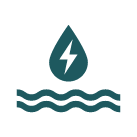The Burrow

The world is transitioning from fossil fuels to clean renewable energy to help combat climate change.
Luckily, this has positive flow-on effects to what we pay for our energy bills. In particular, if Australia were to have a heavier reliance on renewable energy down the track, particularly the likes of solar power, the cost of sourcing energy could significantly reduce. Cheaper production practises could very well be passed down by energy retailers directly through to customers, making it more affordable to consume electricity.
So how is our nation tracking in this regard? Well, most recently in Australia, Queensland Premier Annastacia Palaszczuk announced that the Sunshine State will have 70% renewable Energy by 2032. This, combined with new research from the energy experts at Compare the Market, shows that Queenslanders are ready to embrace a move away from energy generated through fossil fuels.
From a survey of 1,007 adults, we can reveal that just 16% of Queenslanders said they think Australia should rely more on coal as an energy source, compared to more than three-quarters (76%) who’d prefer solar, 43% that would prefer hydropower, nearly half (49%) who’d prefer wind energy and just 16% who’d prefer natural gas.
Data also shows that Queenslanders are feeling the pinch of higher gas bills and are trying to reduce them by:
Additionally, Queenslanders are trying to reduce their electricity bills by:
However, moving to renewable energy isn’t as easy as flipping a light switch.
In this article, we also explore eight Organisation for Economic Co-operation and Development (OECD) countries and take a look at their untapped renewable energy resource capacity that could potentially be harnessed to create clean electricity.
For each nation, we look at whether they may have unharnessed renewable energy from four different types of green power.

Drawing power from water involves hydroelectric dams that use passing water to turn a turbine1 and tidal energy from the ocean.2

Wind power harnesses natural wind flows and currents to turn a wind turbine and create electricity.3

Below the Earth’s surface are pockets of steam, and their heat can be turned into geothermal energy.4

Sunlight can be harnessed by photovoltaic (PV) cells, or the sun’s heat can be concentrated through mirrors to create solar thermal energy.5
A majority of America’s states have a renewable energy target to increase the production and consumption of renewable energy, though criteria and details differ. These policies provide subsidies and Renewable Energy Credits to encourage power generators to invest in renewable energy. Eleven states currently plan to go 100% renewable and emission-free by 2050 or earlier.6

The United States of America (USA) has plenty of space and access to hydroelectric power. Almost every state already has at least one hydroelectric dam, with most hydropower being generated in Washington, California and Oregon.7
A report in 2016 by the U.S. Department of Energy’s Wind and Water Power Technologies Office found that hydroelectric generation could be increased by 49 GW before 2050.8 That’s enough to power over 4,500 homes.9 This would be achieved by installing new hydroelectric dams and retrofitting a number of existing dams.
There is also a potential 2.64 trillion kWh of annual electricity generation from ocean waves10– roughly half the 4.13 trillion kWh of electricity that was generated from all sources in America in 2019.11 Wave power is currently under development, and the U.S. Energy Information Administration notes several locations such as the Cook Inlet of Alaska, Maine and the West Coast could make for strong wave energy candidates.
Unsurprisingly, wind power requires high and steady winds. The National Oceanic and Atmospheric Administration (NOAA) notes that areas of the United States with the highest wind speeds are in the north, along the East Coast and areas of central America.12
Wind power is cost-effective and abundant in almost all states, with the highest potential in states such as Texas, Minnesota and New Mexico. 13 However, there are a few issues with it:

The USA Department of Energy states that there’s huge untapped potential for geothermal energy in America, with a 26-fold increase to current geothermal electricity generation levels. However, the Department of Energy notes that there’s also a significant cost barrier to harnessing this source of energy.16
While it’s feasible to access energy from heat sources underground, and numerous favourable sites across Alaska and Western America have been proposed,17 the technology is expensive and still under development.18

America has great untapped potential for solar electricity. It would only take 0.6% of the USA’s total surface area to be covered in PV solar panels to power the entire country, according to the Office of Energy Efficiency and Renewable Energy.19
Large swathes of America’s west and south are prime locations for solar power stations due to high amounts of daylight.20
As a part of the Paris Agreement, Japan hopes to reduce greenhouse gas emissions by 80% before 2050 through a mix of renewable energy sources, incentives, policies and projects.21

With limited space on land for hydroelectric dams and power stations, wave and tidal energy has seen increased interest from the Japanese Government. Surrounded by ocean, there’s plenty of available water to generate power.
Wave and tidal energy are still under development around the world, and it can affect ocean traffic and marine life, which could affect its feasibility in Japan due to the nation’s emphasis on fishing and shipping.22 Japan has begun demonstration tests on a number of different types of tidal energy generation technologies to ascertain the effectiveness of ocean-based hydropower.23

Numerous factors have inhibited the growth of wind power as a renewable energy source in Japan. The technology is not currently cost-effective due to higher than average costs.24
Limited land space is also an issue.
As with hydroelectricity, Japan has begun to look offshore for its wind turbine sites. Multiple locations have been identified as strong candidates for offshore wind farms, though fishing vessels and trade routes will need to be accounted for as Japan engages stakeholders to plan offshore wind power farms.25

Japan is famous for its hot springs, and the island nation has abundant geothermal resources. It’s estimated the total untapped geothermal resources is equal to 23,470 MW. This makes it the third-highest in the world after Indonesia and the USA in terms of potential energy.26
What stops geothermal energy having a higher untapped potential ranking score is the high upfront costs for geothermal energy, and over half of Japan’s geothermal energy sources are in protected national parks.27

While Japan already has many solar panels installed on buildings across the country, there’s still a high untapped solar energy potential.
Feed-in tariffs (FIT) schemes – where the government pays a little bit of money for power produced and sent back to the grid – were introduced in 2012. This helped encourage local investment in renewables, and solar energy costs were lowered for users as a result.31
Canada aims to source 90% of the nation’s energy generation from emission-free sources by 2030.32 To get there, the Canadian Government established the Pan-Canadian Framework which includes measures such as pricing carbon, clean energy funding and plans to adapt to a changing climate.33

Canada generates more than half of its energy from hydropower.34 While there are hydropower plants across the country, Canada’s lakes, rivers and ocean waters provide additional opportunities to create electricity from water. Multiple large-scale hydro projects are already under construction across Canada.35
The Marine Energy Technology team is working on multiple hydroelectricity projects with the support of the Canadian Government.36 It’s estimated there is a potential 35,700MW of tidal energy alone in Canadian waters.37

There are many prime locations for future wind farms in Canada. Sites along Canada’s south and east, as well as numerous other sites dotted around the country and Hudson Bay, are already in use.38 Between inland locations such as the southern Prairies or the Gulf of St. Lawrence to coastal and off-shore areas, there is ample real-estate to access untapped sources of wind power.39
Canada’s cold weather can affect the feasibility of wind power in certain locations. A research project between 2010 and 2016 by CanmetENERGY found that during winter, there was an average loss in the monthly energy output of 3.9%, with sites in the coldest parts of Canada having the highest losses in energy due to the extreme weather.40
Another issue is that remote generator locations can lead to connection issues due to their distance from the grid, and not every site may be practically feasible for a wind farm.41

Geothermal energy is a mostly untapped source of energy in Canada. There are a few geothermal demonstration projects underway, with the highest temperatures in British Columbia, Northwest Territories, Yukon and Alberta.42
Currently, geothermal technology is not cost-effective in Canada due to the great distances that need to be drilled to access the strongest geothermal energy spots. Current projects are hoping to find ways of making geothermal energy more feasible in Canada.43

In 2017, Natural Resources Canada estimated that half of the nation’s residential electricity needs could be covered with the installation of PV solar panels to residential buildings.44 Solar electricity generation is expected to triple in Canada by 2040.45
While the best locations for solar energy are in central and southern Canada,46 most major cities are on par with any other major city on Earth.47
Germany is a member of the European Union (EU), who revised their greenhouse gas emission reduction targets in September 2020. EU member states are working towards generating a third of their electricity from renewable energy, reducing emissions by 40% (compared to 1990 levels), and the improving energy efficiency of renewable power sources.48

In Germany, most inland sources of hydroelectricity are already being harnessed.49 In fact, the amount of hydroelectricity generated has hardly changed between 1990 and 2016.50 This leaves the northern coasts along the North Sea and Baltic Sea for ocean energy – though the amount of hydropower that could be generated from such technologies is expected to be limited.51
Future developments of ocean and tidal wave power could help make untapped hydroelectricity a more viable source of potential renewable energy.52

Currently, wind power makes up the bulk of renewable energy in Germany. The technology is well developed and in action inland and off-shore, with future expansion in both areas still possible. In coastal areas, older turbines will be replaced with more modern and efficient energy generators.53
However, the power generated from off-shore wind farms costs roughly twice as much as wind power generated on land.54 A large factor behind this is the cost involved in establishing, maintaining and connecting these water-based wind farms to Germany’s energy grid – though future innovation and development may help reduce this cost.55

Geothermal energy is a largely untapped renewable resource in Germany. Most geothermal plants are used for heating, and can be found in the Bavarian Molasse Basin, Upper Rhine Graben and North German Basin.56
It’s estimated that accessing geothermal energy could cover Germany’s entire energy needs with plenty to spare. The difficulty is that deep geothermal energy (400m or more below the surface) is costly to access.57 Additionally, the rocks and minerals can clog wells and damage equipment, making it a very expensive and tricky source of energy to obtain.58

While Germany has already begun to harness solar power, there’s still plenty of potential for this source of renewable energy. The technology is already well-developed in the country, which helps bring down generation costs. Additionally, it’s estimated that PV solar can generate 50% of Germany’s electricity consumption needs on a bright sunny day.59
Most of Germany’s solar potential will be found in the centre and southern parts of the country, where there’s more sunshine.60
Multiple government-funded research projects are underway, focusing on increasing energy efficiency of renewable energy generators and reducing the running costs of solar panels.61
In 2020 the UK announced further funding, job creation and new renewable energy sites to help achieve a net zero greenhouse gas emission target by 2050, in addition to targets set by the Climate Change Act in 2008.62

There’s limited potential for hydroelectricity on land, as the UK Government has noted that the most productive hydropower sites have already been harnessed.
However, there’s potential for wave energy. As an island, the UK is surrounded by water and the strong currents of the Atlantic and the English Channel. The UK Government is currently exploring the potential of ocean energy and is calling for input from various stakeholders.63

While the UK already has the largest generation capacity of offshore wind farms in the world, there’s still plenty of untapped potential for this green energy source.64 The UK Government plans on expanding offshore wind power to produce enough energy to cover every home by 2030.65
Onshore wind power may be limited due to land space and physical requirements, but the isle’s windy seas could provide a great source of untapped energy for years to come.

Over the years, several studies into the geothermal energy potential of the UK have been carried out, with conflicting results. While some reports found there was substantial geothermal energy, most noted that due to the depths that would have to be drilled, the actual energy that could be harvested is much lower than the theoretical energy potential.66

Solar energy has seen steady growth in the UK in recent years,67 but limited land space may limit how much additional output can be generated. Most sunny areas are in the south of England, with central and northern regions of the UK receiving less sunlight that can be harnessed by PV solar panels.68
The UK Government still has plans for expanding its solar capability and has put aside funding to help support solar projects across the country.69
Through a liberal approach that favours private investment and ownership of small, medium and large-scale power plants, Turkey is seeking to have 30% of its energy be generated by renewable sources by the end of 2023.70 Turkey is also a member of the EU and is subject to the EU’s renewable energy targets.71

Turkey has a number of hydroelectric power stations and was the second-largest producer of hydroelectric power in Europe for 2020.72 This is a remarkable achievement given that Turkey is a largely arid land with strict and careful distribution and management of its in-land freshwater resources.73
It also means that there’s little untapped potential left, though wave and ocean energy could be another source of hydropower. However, the Turkish Government hasn’t currently listed ocean power as a potential energy source in its 2023 renewables strategy.74

There’s high untapped potential for wind energy in Turkey. The technology is one of the most cost-effective options in the country, and the Turkish Government plans on spending USD$24.78 billion to increase generation to 20,000MW by 2033.75

Turkey has invested heavily in geothermal energy in the past decade, quintupling the amount of energy created between 2012 and 2017.76 A feed-in tariff (where the government pays a generator for surplus energy that’s fed back into the energy grid) and other funding policies have helped establish 1,500MW of geothermal power by June 2020. While the feed-in tariff is set to end in 2020, a new one has been announced to replace it.77

Wide areas of Turkey would be suitable for solar power stations, and the country already has a number in use. At the end of 2018, solar power generated 5.068GW of electricity.78 By 2023, Turkey plans on doubling this to 10GW of electricity from solar, indicating that the technology is feasible, available and untapped.79
Australia’s Renewable Energy Target (RET) had an objective of achieving a minimum of 33,000GWh of clean electricity generated by 2020, which was accomplished in 2019. The RET involves subsidies such as large-scale generation certificates (LGCs) and small-scale technology certificates (STCs). Power stations sell LGCs to large-scale users to help these users meet their energy consumption obligations and fund the development of renewable energy. STCs are given to individuals and businesses that install renewable energy systems at their home or business.80

Australia has over 120 hydropower stations, generating over one-quarter of the nation’s renewable energy, and hydropower accounts for just over six per cent of the country’s total electricity generation. Despite a large number of operational plants, there are still plans to expand current sites or build new plants in the mainland.81
As a land ‘girt by sea,’ there is expansive untapped ocean energy potential too. The Commonwealth Scientific and Industrial Research Organisation (CSIRO) estimates that Australia could generate 11% of its energy needs from wave energy alone by 2050.82

There is ample opportunity to harness wind power in Australia, and as of 2018, there were almost 100 wind farms around the continent.83 Wind energy is the cheapest source of large-scale green power in Australia, as of 2018.84
The best wind resources are found in coastal regions along Australia’s bottom half in Western Australia, South Australia, Victoria, Tasmania and New South Wales as well as higher altitudes along the Great Dividing Range.85 Some inland sites are also strong sources of wind power, and one of Australia’s biggest wind farms, Capital Wind Farm, generates 405,600MWh of electricity each year.86
The Australian Government is also exploring the potential for an offshore wind farm to further harness untapped wind power, with testing underway off the Gippsland coast in Victoria.87

Australia has some potential for geothermal energy. It’s been estimated that one per cent of the energy sourced from five kilometres deep (so long as it is over 150°C) could meet the nation’s energy needs for 26,000 years.88
However, due to the basins of geothermal energy being so deep underground, there’s an extremely high cost involved in accessing it, and a degree of risk involved with drilling so far below the Earth. Australia is currently exploring ways of accessing this potential energy source while reducing risk and costs.89

Australia has plenty of sunshine and space for establishing large-scale solar plants in the future.90
Solar tech development is receiving strong support and funding from the Government, which has led to increasing cost efficiencies in Australia that almost rival wind power.91 A study by the University of Technology Sydney, University of New South Wales and the Australian PV Institute found that adding PV solar panels to rooftops on industrial and commercial buildings could generate 179GW of electricity. As of 2019, only five per cent of Australia’s potential rooftop solar is being harnessed.92
At the end of 2019, 59 large-scale solar projects were under construction in mainland Australia,93 and the nation is exploring the potential for offshore solar power as well.94
As of 2018, 54% of Sweden’s energy came from renewable sources, and the nation plans on generating 100% of their energy from renewable sources by 2040.95

Hydropower is one of Sweden’s biggest sources of renewable energy, accounting for half of the nation’s baseload production.96
The amount of untapped hydropower in Sweden may be difficult to judge. Sweden has updated its environmental protection codes following a 2012 report, and there are concerns that a number of older hydro plants won’t pass the new codes and may have to shut down.97 These environmental codes will also make it difficult to build new hydropower sites in Sweden.98
Ocean energy could be another avenue for harnessing hydroelectricity, but the Swedish Government notes that it is still relatively undeveloped and it’s not currently an economically viable option.99

Wind power has been the fastest-growing source of clean energy in Sweden in recent years, with 3,600 wind turbines in operation, accounting for 12% of Sweden’s electricity generation.100 Wind power is a key element to Sweden’s plan of generating 100% of its energy needs from renewable sources by 2040, and the Swedish Government is supporting multiple new facilities.101
The Swedish Government noted in 2018 that there were 313 potentially untapped wind power sites, including 284 on land and 29 offshore. Additionally, wind power has become an extremely cost-effective source of power in Sweden, which helps make it a viable untapped source of energy.102

There is minimal untapped geothermal energy potential in Sweden. This is because of the dense bedrock underneath the country, which makes it very difficult to access geothermal flows.103

The Swedish Government plans on investing heavily into solar as it switches over to green power.104 It’s cost-effective,105 and while the strongest source of potential solar power may be limited to the island of Gotland, there’s still opportunity across mainland Sweden for productive solar panels.106
Additionally, offshore solar farms could provide another method of generating solar electricity, but the costs involved are higher than traditional land-based solar.107
Brought to you by Compare the Market – making it easier for you to search for great deals on your Energy Plan.